With the horseback world champs cancelled, it was time for something different. By the competition organiser Claire Sawyer
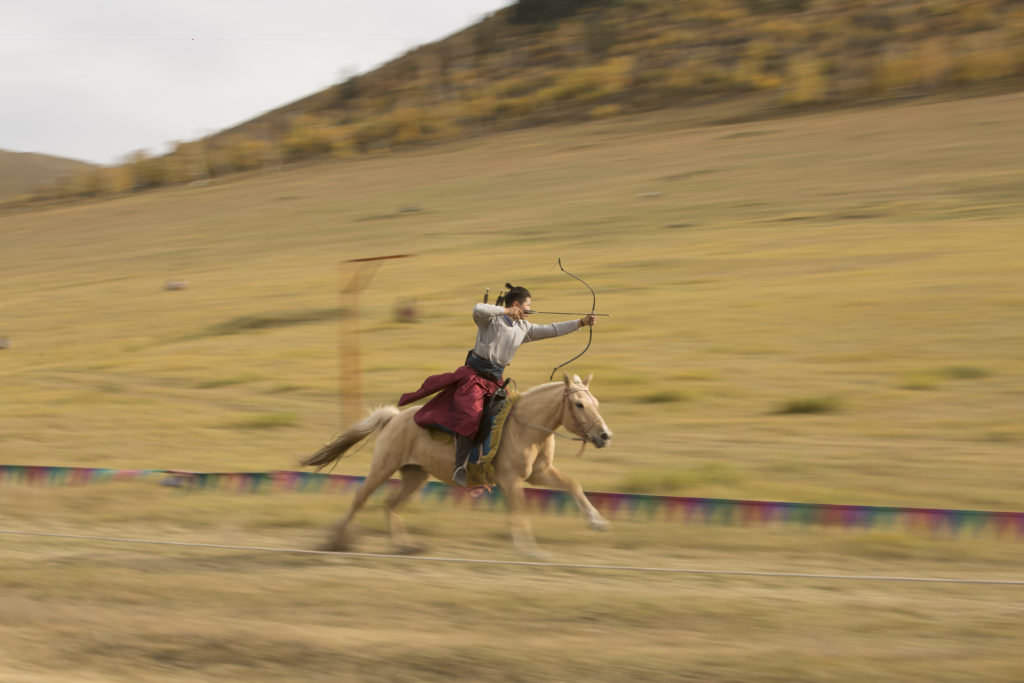
Early 2020 brought a gradual realisation that everything would be different this year. As the International Horseback Archery Alliance (IHAA) cancelled our World Championships in Paris we formulated plans to try and give our sporting community something to engage with, and the idea for the 2020 World Grand Prix was born.
The WGP would be a worldwide postal competition where small competitions would be run locally, thereby only requiring small groups of people to assemble and avoiding the travel restrictions associated with the coronavirus pandemic.
The IHAA is a leading world body for horseback archery affiliated to FITE (the International Federation for Equestrian Tourism). It has 34 member countries on five continents.
Since its earliest days the IHAA has valued all different styles of competition track, embracing the different regions and cultures that contribute to the rich variety in our sport. Over time our primary focus for competition became the combined discipline Horseback Archery Eventing, loosely based on the equestrian sport of eventing.
Each track requires subtly different skills in both archery and riding and all three contribute equally to the end result. Our champion horse archers and horses are those who can adapt their technique to excel in each: the straight track Raid and Tower events and the long winding Hunt track.
In the World Grand Prix we used shorter 90m tracks to enable as many countries to join as possible, and the Hunt track was replaced by the newly designed Skirmish track. A published rulebook and a track validation process helped ensure that the tracks at all competition venues were the same.
In horseback archery men and women always compete on an equal basis. 31 teams from 21 countries signed up to participate in the wGP. Each team had to consist of between five and nine competitors which were selected by their national governing body and was required to return nine sets of scores (therefore teams of fewer than nine riders would have some individuals compete twice). Of the 31 teams, six were junior teams (aged 17 or younger), and four were youth teams (aged 21 or younger).
Scores reflect both the arrow score and your horse’s speed. Different regions have different preferences for archery technique and riding speed and it has taken several years of testing and track evolution to get to the point where there is no bias in the rules and all regions can compete on an equal footing.
These IHAA competition tracks have been designed so that the highest scores can be achieved using a variety of tactics; to this end, the weighting of arrow hits, multi-hit bonuses and speed points is finely tuned.
THE TRACKS
The Tower track is named after the tower stack which is set back 9m from the midpoint of the 90m track. On this tower are three round 5-zone target faces, 90cm in diameter.
As well as points scored with the arrows, speed points are awarded for riding faster than 18 seconds, as long as three arrows have been shot. A multiplier is applied to the speed points depending on whether one, two or more arrows scored. Each rider will complete six competition runs on this track.
The challenge of this track is the constantly changing range: from shooting 45m forward, 9m to the side, then a 45m Parthian shot at the end – this is where the completely instinctive aiming of horseback archers helps.
The 45m back shot, as you’re about to cross the finish line is often referred to as a “Hail Mary” shot by those who release the arrow with a hope and a prayer. The applause and celebration by fellow competitors and spectators is always loudest when these score well!
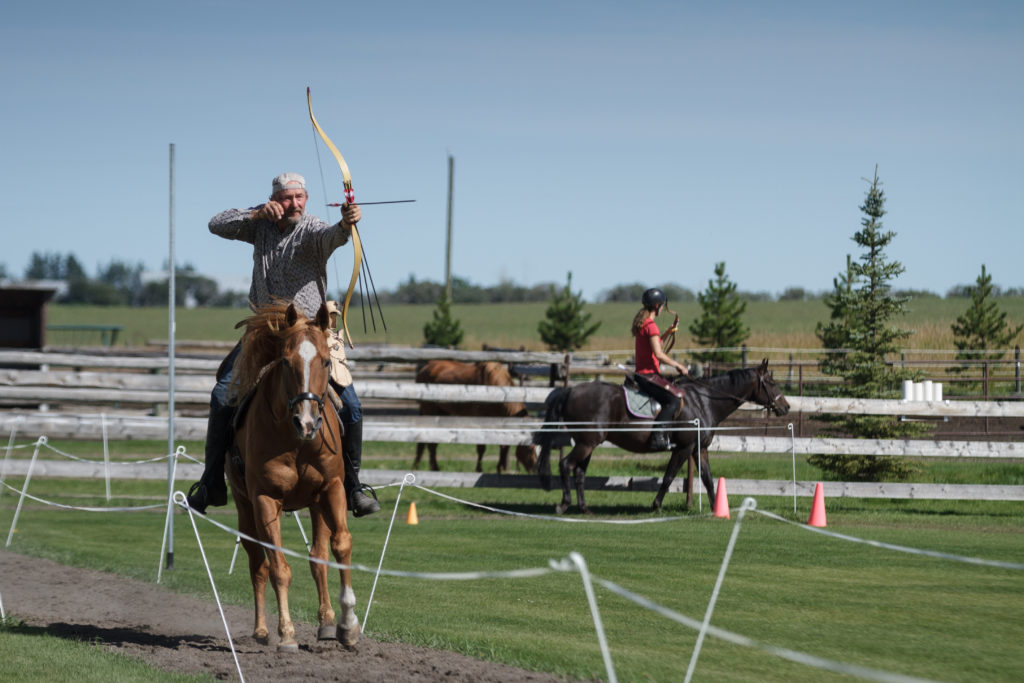
Most competitors will hold their arrows in their bow hand to allow quicker nocking and shooting. The best can hold ten arrows in this way and shoot them all within the time allowed – there is no limit on how many arrows you can release.
In this event very high scores have been most often achieved on 15 to 16 second runs with six or seven arrow hits, but comparable scores can be made on 11 second runs with three or four arrows hitting each time.
The Raid is the fastest track with some horses covering the 90 metres in eight or nine seconds. If you can still nock and accurately shoot whilst moving at 40km/h, this is the formula for the highest scores.
However it is still possible to do well at slower speeds if your arrow points are consistently high and you collect all your multi-shot bonuses. In this event arrows must be carried in a quiver; quivers on the right or left hip are commonplace, and back quivers are gaining popularity.
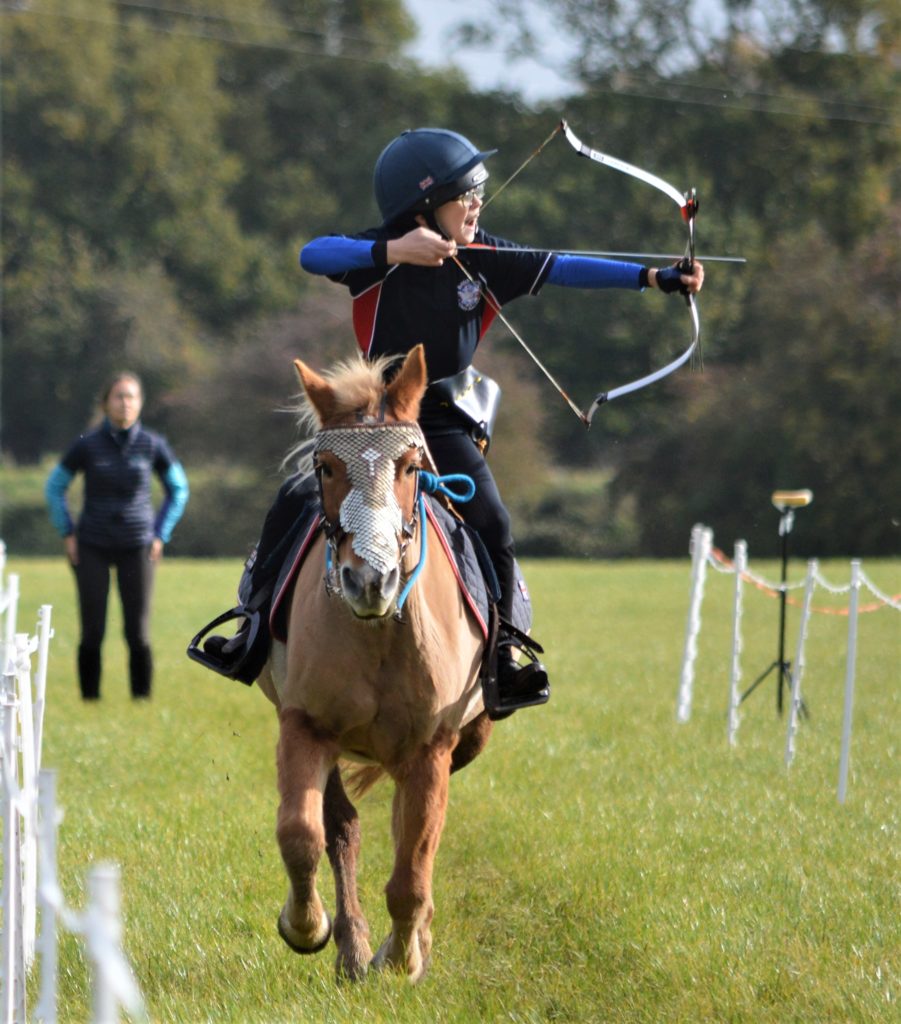
Each competitor rides six runs of the Raid 233 track: two on the double, two on the angled triple and two on the triple shot. As well as the arrow score on the target there is also a multi-hit bonus available if you hit all of the targets available on a given run.
Speed points may be gained, or lost, at a point per second, for completing the track faster or slower than the par time of 14 seconds, although it is necessary to hit one target on the double shot and two targets on the triple shot to collect your speed points; to ensure the onus is on accurate shooting over fast riding.
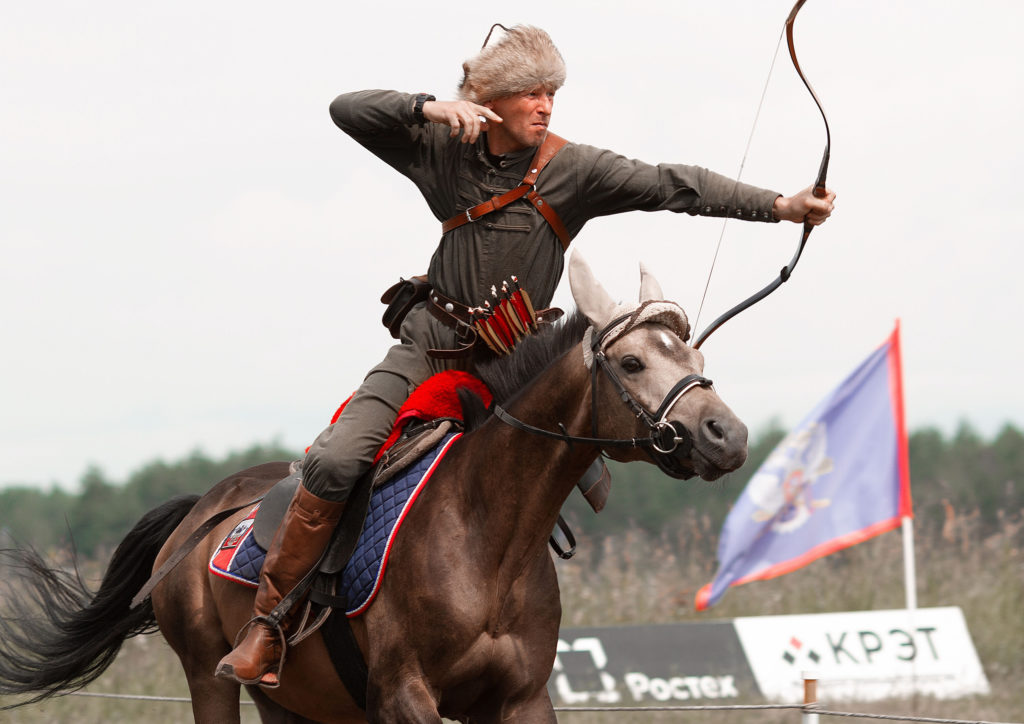
The Skirmish is a difficult track containing five targets within 90 metres. First up is the kikaç, using a WA40 target set very close to the track and requiring a downwards and backwards shot. The kikaç target is a traditional Turkish one and is suitable to be shot with the jarmaki technique where the string is drawn behind the neck.
For those interested; this technique was described in the 14th century Furusiya manual translated in “Saracen Archery” (ed. Latham & Paterson). All the rest of the targets are standard round WA80 faces. Set 7m from the track edge are targets two to four, a front shot, a ground shot (the target lies flat on the ground next to the track), then a back shot.
The fifth and final target is placed on the offside adjacent to the finish line; some horse archers will swap their bow into the other hand to shoot an offside target, though the angle of this one makes it possible to shoot it accurately with the bow in your normal hand, through significant twist in the core and rotation in the saddle.
For the skirmish, time points are awarded (and lost) at 1.5 points per second and two targets must be hit in order to gain these time points. The scoring system is carefully balanced to recognise the increased difficulty of facing so many targets at speed, but it also demands accuracy and consistency to score well.
Multi-hit bonuses are available – three points for scoring on any four targets, four points for hitting all targets. To shoot at all five targets in the skirmish demands athleticism plus good spatial awareness and balance, as there is a lot of twisting in the saddle. (One well-respected horse archer suggested that it was a track which favoured younger men and women than himself.)
THE TEAMS
The top scoring teams truly represent the full cross section of the horseback archery world community both in terms of geographic spread and regional style. The Hungarians, French and Dutch tend to use Mediterranean draw and ride a little slower; the Turks and Mongolians are faster riders and shoot predominantly with thumb draw (or else with an index finger lock).
Preference in using a static or working recurve and bow length also varies with region and archery technique, but we all shoot off the hand and predominantly shoot carbon arrows with feather fletchings and plastic nocks that are angled to facilitated blind nocking (we have to keep our eyes on the next target).
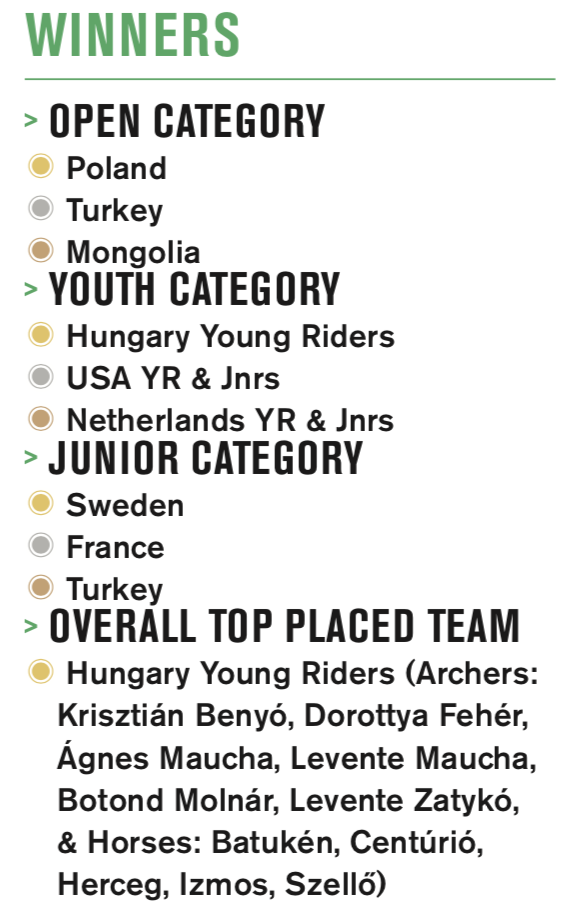
In all, 245 competitors took part within the four month competition period. Altogether more than 4000km of competition track was galloped during 78 local events.
The archers were aged between 10 and 64 years old, and the equine side of the partnerships ranged from a tiny Shetland (1.05m at the withers) to a massive Shire x Clydesdale (1.75m). The team lists are interesting in showing how many families enjoy horseback archery together.
One great success of the wGP was the participation of the iHBA team. Inclusive horseback archery (iHBA) is a new initiative of the IHAA and,in contrast to many para-sports, includes mental health and learning difficulties plus a broader range of physical conditions than usual.
The iHBA team included individuals from USA, UK, Netherlands and Denmark. The team competed on the same tracks, and under the same rules, as everyone else despite contending with challenges such as rheumatoid arthritis, lymphedema, autism and blindness.
As their team manager I was overwhelmed by the support and encouragement within the team and I hope that iHBA will grow at both grass roots and elite level over the coming years.

